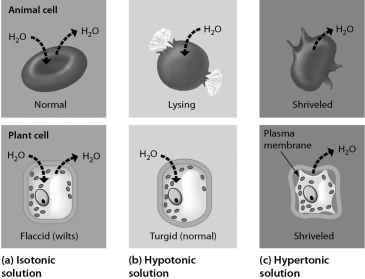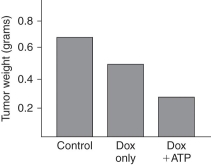A) sugar
B) ATP
C) DNA
D) fat
Correct Answer

verified
Correct Answer
verified
Multiple Choice
Substances that plug up an enzyme's active site are ________.
A) enzyme substrates
B) enzyme inhibitors
C) enzyme catalysts
D) enzyme products
Correct Answer

verified
Correct Answer
verified
Multiple Choice
On a lab bench,there are four balloons filled with identical volumes of different salt solutions: 0% (balloon A) ,5% (balloon B) ,10% (balloon C) ,and 15% (balloon D) .There are also four beakers each filled with identical volumes of a 10% salt solution.The balloons are semi-permeable; that is,only water can enter and exit the balloon.All four balloons are placed in separate beakers at the same time and are allowed to come to equilibrium.Which is the correct order of balloon volumes at equilibrium,from largest to smallest?
A) A < B < C < D
B) D < C < B < A
C) D < B < A < C
D) All balloons will be of equal volume at equilibrium.
Correct Answer

verified
Correct Answer
verified
Multiple Choice
Examine the cells below.Cells with a higher concentration of ions than the surrounding medium tend to ________. 
A) stay about the same size and shape
B) expand
C) shrink
D) divide
Correct Answer

verified
Correct Answer
verified
Multiple Choice
When two solutions that differ in solute concentration are placed on either side of a selectively permeable membrane,and osmosis is allowed to take place,the water will ________.
A) exhibit a net movement to the side with lower water concentration
B) exhibit a net movement to the side with higher water concentration
C) exhibit a net movement to the side with lower solute concentration
D) exhibit an equal movement in both directions across the membrane
Correct Answer

verified
Correct Answer
verified
Multiple Choice
Which of the following processes could result in the net movement of a substance into a cell,if the substance is more concentrated in the cell than in the surroundings?
A) active transport
B) facilitated diffusion
C) diffusion
D) osmosis
Correct Answer

verified
Correct Answer
verified
Multiple Choice
Usually,enzymes are ________.
A) fats
B) steroids
C) chemical reactions
D) proteins
Correct Answer

verified
Correct Answer
verified
Multiple Choice
The region of an enzyme to which a substrate binds is called the ________ site.
A) active
B) substrate
C) enzymatic
D) inactive
Correct Answer

verified
Correct Answer
verified
Multiple Choice
Humans convert approximately ________ of the energy stored in food to useful work.
A) 22%
B) 34%
C) 55%
D) 99.9%
Correct Answer

verified
Correct Answer
verified
Multiple Choice
Read the following scenario to answer the following question(s) .
Biomedical scientists have recently developed an anticancer drug delivery system that sneaks the anticancer drug into cancer cells before releasing it. They were able to do this by using two sets of liposomes. An anticancer drug (Doxorubicin (Dox) ) bound to DNA molecules was added into one set of liposomes (type A) , and a high concentration of ATP molecules were added to the other set of liposomes (type B) . The drug is inactive when bound to DNA molecules. Researchers inject both types of liposomes (A and B) into cancer cells, and upon doing so their contents are released. The ATP molecules (from liposome type A) bind to the DNA molecules (from liposome type B) and activate the drug, thus inducing cell death and decreasing tumor size.
Mice with breast cancer tumors were treated with this liposome system to test the effectiveness of the drug. The scientists performed three trials one with both types of liposomes (Dox + ATP) , one with just the drug (Dox only) , and one with a salt solution (control) . Examine the figure below and answer the following questions.
 -Why did tumor size decrease in the Dox only experiment to a lesser extent than the Dox + ATP experiment?
-Why did tumor size decrease in the Dox only experiment to a lesser extent than the Dox + ATP experiment?
A) ATP is actually the drug that is killing the cancer cells, not Dox.
B) Dox is always active in cancer cells, so it should be able to kill some cells without ATP.
C) When ATP is lacking, not as much Dox can enter the cell via facilitated diffusion.
D) There is some ATP in the cancer cells normally, which acts to activate Dox.
Correct Answer

verified
Correct Answer
verified
Multiple Choice
A balloon permeable to water but not to glucose contains a 10% glucose solution.A beaker contains a 5% glucose solution.Which of the following is TRUE?
A) The solution in the beaker is hypertonic relative to the solution in the balloon.
B) The solution in the balloon is isotonic; the solution in the beaker is hypertonic.
C) The solution in the balloon is hypotonic relative to the solution in the beaker.
D) The solution in the balloon is hypertonic relative to the solution in the beaker.
Correct Answer

verified
Correct Answer
verified
Multiple Choice
When a person cries,tears are exported from cells through the process of ________.
A) facilitated diffusion
B) active transport
C) endocytosis
D) exocytosis
Correct Answer

verified
Correct Answer
verified
Showing 41 - 52 of 52
Related Exams